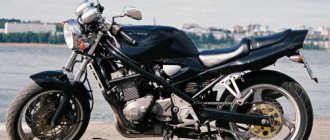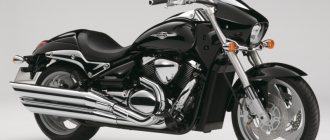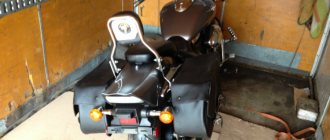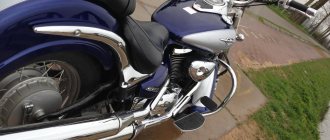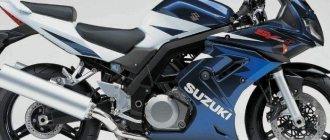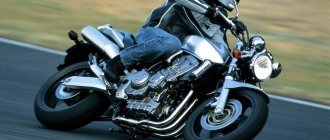Ten years is a long time. How have motorcycles changed in ten years? Today we have two popular cars as patients: the old model Suzuki SV 650 and the same, but new one.
Suzuki SV 650
I swing my leg over the seat of the Suzuki SV 650, which has not changed since 2007, take the steering wheel, start the engine and look at the clock. At that moment, I had the impression that the time machine had taken me back a good few years.
The recipe for the Suzuki SV, first revealed in 1999, was as simple as it was ingenious: a strong twin-cylinder engine accompanied by a timeless yet interesting design, without the bike's price being a drain on the wallet. This is how a very good universal naked bike was made. However, it had its drawbacks. For example, the Suzuki SV models of the first years of production had the same suspensions.
Suzuki engineers have spent years perfecting the SV 650 thanks to our riders, their pressure and changing regulations. In the first version, power supply was the task of classic carburetors. New regulations introduced in 2003 meant that the car received fuel injection, two flaps in each of the intake manifolds and a catalytic converter. The Suzuki St. 650 engine has lost a little of its sharp character, but its operating culture has improved significantly.
suzuki 650 motorcycle
Another change to the Suzuki SV 650 on the way to perfection
The 2007 season brought further improvements: the brake system received ABS, the engine received two spark plugs per cylinder, and the cylinder heads themselves changed. For this reason, it was necessary to redo almost all elements of the ignition system, injection system, air filter housing and muffler.
Thanks to all this and adjustable catalysts, the requirements set by the Euro 3 standard were met. Reactions to gas additions and load changes became smoother. The maximum power of the sv650s was 72 hp.
The two-piston terminals are identical. And rightly so - why change something that works properly? The ABS switch has been modified to accommodate this. Of course, modern ABS works more accurately. In the new model, its sensor is installed on the left side of the wheel.
suzuki 650 motorcycle
The analog tachometer is clearer, but the 2021 model's LCD display provides more information.
Technical changes to the Suzuki sv650s engine are an evolution, not a revolution. New regulations forced the introduction of fuel injection and catalysts.
In terms of appearance, the 2007 version of the Suzuki SV 650 was dominated by sharper lines. The fuel tank was wide and the rear end looks rather oversized compared to the last model. Although the new bike, 10 years younger and seemingly less bulky, weighs exactly the same as its predecessor, or 199 kg to be exact.
suzuki st
The dashboard of the old Suzuki SV 650 “smells like a dead mouse”, but in my opinion, the analog tachometer is much clearer than the digital one. There's also one small thing I appreciate about the old SV: I really enjoy watching the tachometer move up the dial after each gear shift. It has its own charm.
If you have Scots among your ancestors, you will probably appreciate that fuel consumption has decreased by 0.5 l/100 km over 10 years. This is all the more interesting because both motorcycles have almost the same engine. The ratio of cylinder diameter to piston stroke also did not change, but the compression ratio was slightly reduced.
The changes that have been given to the engine are invisible. Well, aluminum cylinders don't have classic liners. Their insides were coated with a thin layer of wear-resistant oxides. The new pistons are installed better, that is, less loose, moreover, the piston rings have been replaced, the crankshaft has been increased by 10%, and the exhaust valves have a larger diameter.
Result? The new V-twin is stronger than its predecessor and also delivers power smoother, more dynamically and with less vibration.
Suzuki SV 650
In this model, the frame is made of aluminum profiles, and its rear strut is tightened. The split sofa is a distinctive feature of the old SV650. Steel monocoque frame, narrower fuel tank and softer, cooler rear view. The round spotlight is the same as in the 2007 version.
Specifications
| Model | Suzuki SV 650 |
| Motorcycle type | naked |
| Year of issue | 1999-2012 |
| Frame | aluminum tubular – SV650 / SV650S (1999-2002) aluminum cast – SV650 / SV650S (2003-2012) |
| engine's type | 2-cylinder, 4-stroke, V-shaped 90° (L-shaped) |
| Working volume | 645 cm³ |
| Bore/Stroke | 81.0 x 62.6 mm |
| Compression ratio | 11.5:1 |
| Cooling | liquid |
| Number of valves per cylinder | DOHC, 4 valves per cylinder |
| Fuel supply system | Carburetor, 2x Mikuni BDSR39 – SV650 / SV650S (1999-2002) Injector with SDTV (Suzuki Dual Throttle Valve System), 2x – SV650 / SV650S (2003-2012) |
| Ignition type | transistor 1 spark plug per cylinder – SV650 / SV650S (1999-2006) 2 spark plugs per cylinder – SV650 / SV650S (2007-2012) |
| Maximum power | 65.0 hp (48.0 kW) at 9000 rpm - SV650 / SV650S (1999-2002) 72.0 hp (53.0 kW) at 9000 rpm – SV650 / SV650S (2003-2012) |
| Maximum torque | 57.4 Nm (4.5 kg*m) at 7200 rpm – SV650 / SV650S (1999-2002) 64.0 Nm (6.5 kg*m) at 7200 rpm – SV650 / SV650S (2003- 2012) |
| Transmission | 6-speed |
| type of drive | chain |
| Front tire size | 120/60ZR17M/C (55W) |
| Rear tire size | 160/60ZR17M/C (69W) |
| Front brakes | 2 discs, 290 mm, 2-piston calipers (optional ABS from 2007) |
| Rear brakes | 1 disc, 240 mm, 1-piston caliper (optional ABS from 2007) |
| Front suspension | Telescopic fork 41 mm (non-adjustable), travel - 130 mm - SV650 / SV650S (1999-2002) 41mm telescopic fork (preload adjustable), 130mm travel – SV650 (2003-2009) 41mm telescopic fork (preload adjustable), 125mm travel – SV650S (2003-2012) |
| Rear suspension | Pendulum with monoshock absorber (preload adjustment), stroke - 125 mm - SV650 / SV650S (1999-2002) Pendulum with monoshock absorber (preload adjustment), stroke - 137 mm - SV650 (2003-2009) Pendulum with monoshock absorber (preload adjustment), stroke - 134 mm - SV650S (2003-2012) |
| Motorcycle length | 2070 mm – SV650 (1999-2002) 2045 mm – SV650S (1999-2002) 2080 mm – SV650 (2003-2009) 2085 mm – SV650S (2003-2012) |
| Motorcycle width | 750 mm – SV650 (1999-2002) 740 mm – SV650S (1999-2002) 745 mm – SV650 (2003-2009) 730 mm – SV650S (2003-2012) |
| Motorcycle height | 1060 mm – SV650 (1999-2002) 1130 mm – SV650S (1999-2002) 1085 mm – SV650 (2003-2009) 1170 mm – SV650S (2003-2012) |
| Wheelbase | 1430 mm – SV650 (1999-2002) 1420 mm – SV650S (1999-2002) 1440 mm – SV650 (2003-2009) 1425 mm – SV650S (2003-2012) |
| Seat height | 805 mm – SV650 / SV650S (1999-2002) 800 mm – SV650 / SV650S (2003-2012) |
| Minimum ground clearance (clearance) | 140 mm – SV650 / SV650S (1999-2002) 150 mm – SV650 (2003-2009) 155 mm – SV650S (2003-2012) |
| Acceleration to 100 km/h | 3.7 sec |
| Maximum speed | 195 km/h - SV650 (1999-2002) 203 km/h - SV650 (2003-2009) 209 km/h - SV650S (2003-2012) |
| Gas tank capacity | 16.0 l – SV650 / SV650S (1999-2002) 15.0 L – SV650 / SV650S (1999-2002, California) 17.0 l – SV650 / SV650S (2003-2012) 16.0 L – SV650 / SV650S (2003-2012, California) |
| Motorcycle weight (dry) | 165 kg – SV650 (1999-2002) 169 kg – SV650S (1999-2002) 168 kg – SV650 (2003-2009) 172 kg – SV650S (2003-2012) |
ABS is much better
The quiet nature of the Suzuki SV engine goes well with the purpose of the motorcycle. The fact that the bike corners better and is stable in deep builds means it's useful for beginners. Uneven asphalt does not make his behavior nervous.
The fork and center shock performance on this machine is much better than the more comfortable but loosely tightened hinges of 10 years ago.
What about the brakes? The efficiency of the two-piston calipers is nothing to complain about, provided you don't go crazy. But we're not talking about this motorcycle! The biggest criticism of modern motorcycles is that they lack aggressiveness and crisp action.
Huge progress can be seen in the performance characteristics of ABS. Apart from a slight deceleration during braking, the Suzuki stays on course precisely. In the old SV650, where the front discs break the same clamps, the initial braking phase is quite sharp - but when the ABS comes in, the game is over.
The pressure in the brake system drops, the fork relaxes slightly - and at this moment ABS reminds us of its existence. The low frequency operation that was standard many years ago is unacceptable today. The most important thing to me is that the 2007 is stable and predictable under emergency braking.
Suzuki SV 650
Engine Suzuki SV650
It must be said that Suzuki SV650 fans will be incredibly happy to hear that the manufacturer promises that the 2021 motorcycle will be lighter and more powerful. The 645 cc, V-twin engine with two cylinders positioned at an angle of 90 degrees was completely rebuilt and received 60 new parts. Suzuki used Finite Element Analysis to create the new pistons to achieve maximum stiffness without increasing weight. The piston skirts are made from a new composite material to reduce friction. Each cylinder has two spark plugs, Suzuki's dual spool system features 39mm throttle bodies and 10-hole injectors. The new 2 into 1 exhaust system is said to be lighter and also uses a catalytic converter to reduce emissions. The manufacturer claims that the new engine design provides more power to the Suzuki SV650, as well as more torque in the low and mid-range.
Engine Suzuki SV650
Suzuki SV650 chassis
The 2021 Suzuki SV650 chassis has also been completely revised with over 70 new parts and components. The lightweight steel and trellis frame help the bike shed about 7 kilograms in weight compared to the previous SFV650 model. The fuel tank is 63.5mm narrower than the 2015 SFV650, but holds the same amount of petrol. The new fuel tank design makes it easier for the driver to keep both feet on the ground. The suspension is represented by a 41 mm fork and provides 124 mm of vertical travel, the rear shock absorber adjusts the preload in seven positions. Braking duties are handled by dual 290mm discs and dual-piston Tokiko calipers, with a 240mm disc mounted at the rear. The 2017 SV650A features a lighter and more compact Nissin ABS system.
Suzuki SV650
The 2021 Suzuki SV650 features One-Touch Easy Start, just like the 2016 Suzuki GSX-S1000. Starting is facilitated by Suzuki's patented Throttle-body Integrated Idle Speed Control (TI-ISC), which not only monitors engine idle speed but also minimizes emissions. The TI-ISC system "adjusts engine speed at launch and in the low rpm range for smooth power delivery and eliminates the possibility of the pilot accidentally shutting down the engine."
20 years later, the model can be said to have cult status
The latest Suzuki SV650 is equipped with a multi-function LCD display that displays the following information: gear position indicator, digital speedometer, tachometer, odometer, trip meter, fuel consumption meter, range, water temperature level and fuel level. The display backlight has six settings.
Multi-function liquid crystal display
The 2021 Suzuki SV650 will hit dealer showrooms in late spring/early summer. The price is still unknown.
